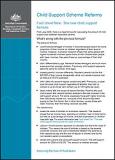Fact sheet Nine: The new child support formula
From July 2008, there is a new formula for calculating the amount of child support paid between separated parents.
What's wrong with the previous formula?
The previous formula:- used fixed percentages of income. It assumed people spend the same proportion of their income on children regardless of their level of income. However, Australian research shows that, while people with higher household incomes spend more on their children than people with lower incomes, they spend less as a percentage of their total income.
- didn't differentiate by age. Research shows teenagers are much more expensive than younger children. Previously, child support payments were the same for children of all ages.
- treated parents' incomes differently. Resident parents had the first $45,505 of their income disregarded, while non-resident parents had as little as $15,378 exempted.
- didn't take into account regular contact very well. Previously, a payer paid the same child support regardless of whether they had no contact or up to 29 per cent contact (up to 106 nights per year).
- dealt unfairly with the issues of second families. Parents who paid child support with second families received a flat-rate increase in the self-support amount. For some, especially those with higher incomes, their new family missed out - because of the amount they were paying to their first family. But in other families, usually those with lower incomes, their first family received very little.
- bases the costs of children on Australian research. The research shows that as income rises, spending on children rises in dollar terms, but falls as a percentage of income, and that expenditure on children rises with age. For more information see Fact sheet Ten: The new child support formula and the costs of children.
- uses an 'income shares' approach to calculate and share the costs of children. This means the cost of children is based on the parents' combined incomes, the cost is distributed between the parents by their capacity to pay and the cost of regular or shared care by the non-resident parent is considered.
- allows both parents the same self-support amount. The self-support amount for 2008 is $18,252. This amount is indexed annually.
- takes the cost of the children from the combined incomes of both parents. For more information see Fact sheet Ten: The new child support formula and the costs of children.
- recognises costs of contact as a contribution to the costs of children.
- For more information see Fact sheet Eleven: Recognising the costs of care.
- treats the children of first and second families as equally as possible by using the cost of the children from the second family in determining the child support payable (rather than a flat increase to the self-support amount). For more information see Fact sheet Fourteen: Second families - new arrangements.
For more detail on the development and operation of the formula refer to -In the Best Interest of Children - Reforming the Child Support Scheme - Report of the Ministerial Taskforce on Child Support (chapters 6, 7, 8 and 9). Examples of how the formula works in different family circumstances can be found in Appendix 1 of the Summary Report.
Please note this fact sheet is for general guidance only. It should not be treated as a complete or authoritative legal statement.
More details about these changes can be found in other fact sheets and on the Child Support Agency website
More information on the Taskforce and how the reforms started is available on this website under Ministerial Taskforce on Child Support.
Last updated:

